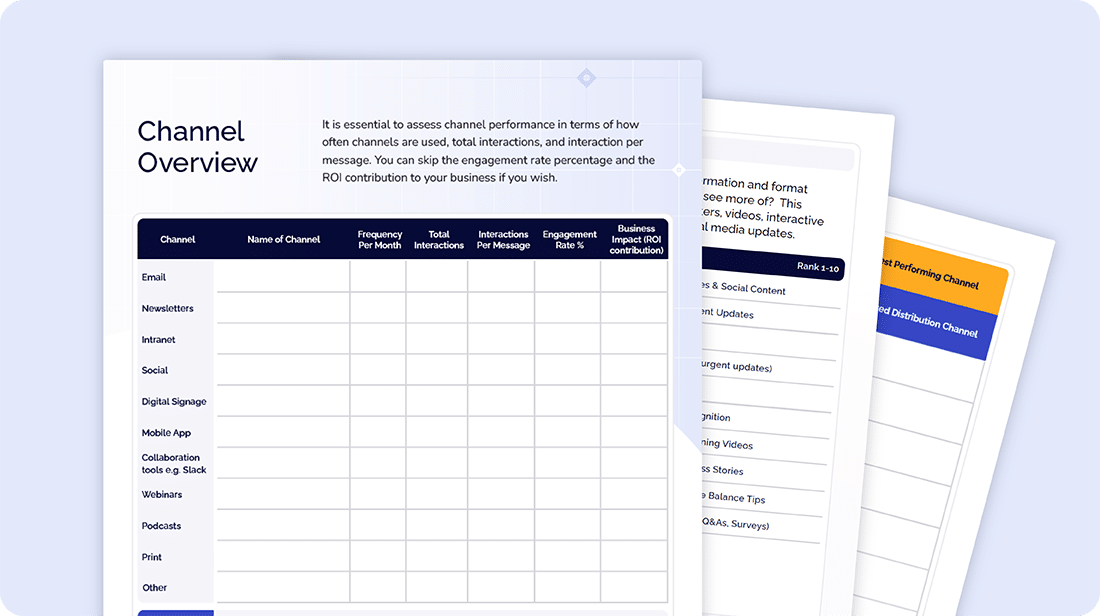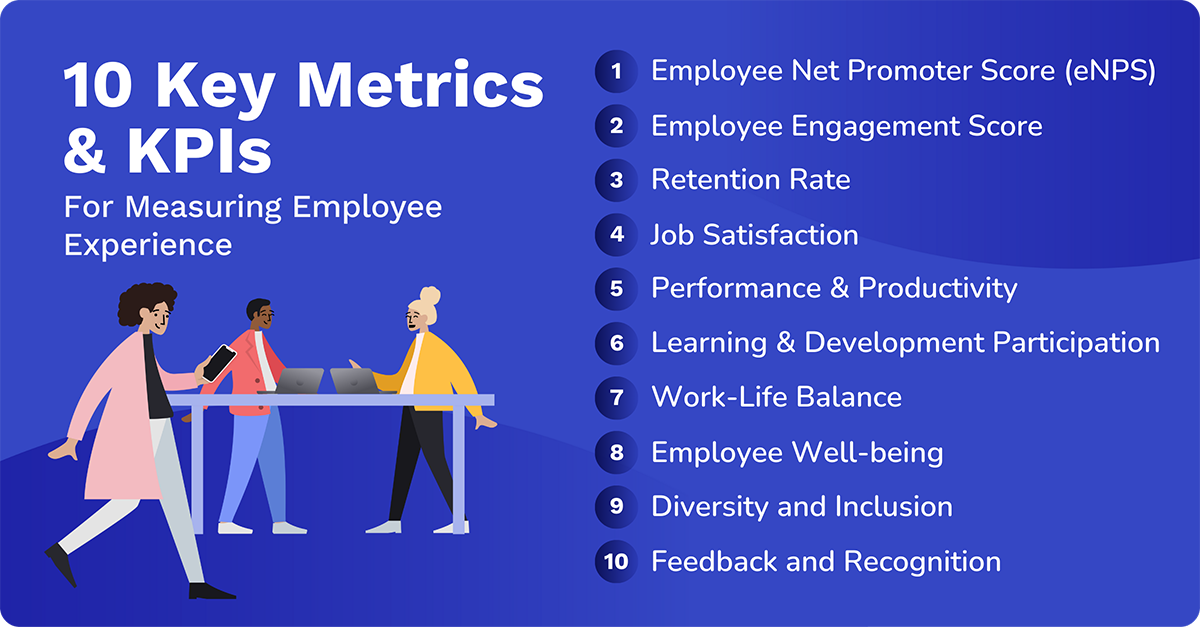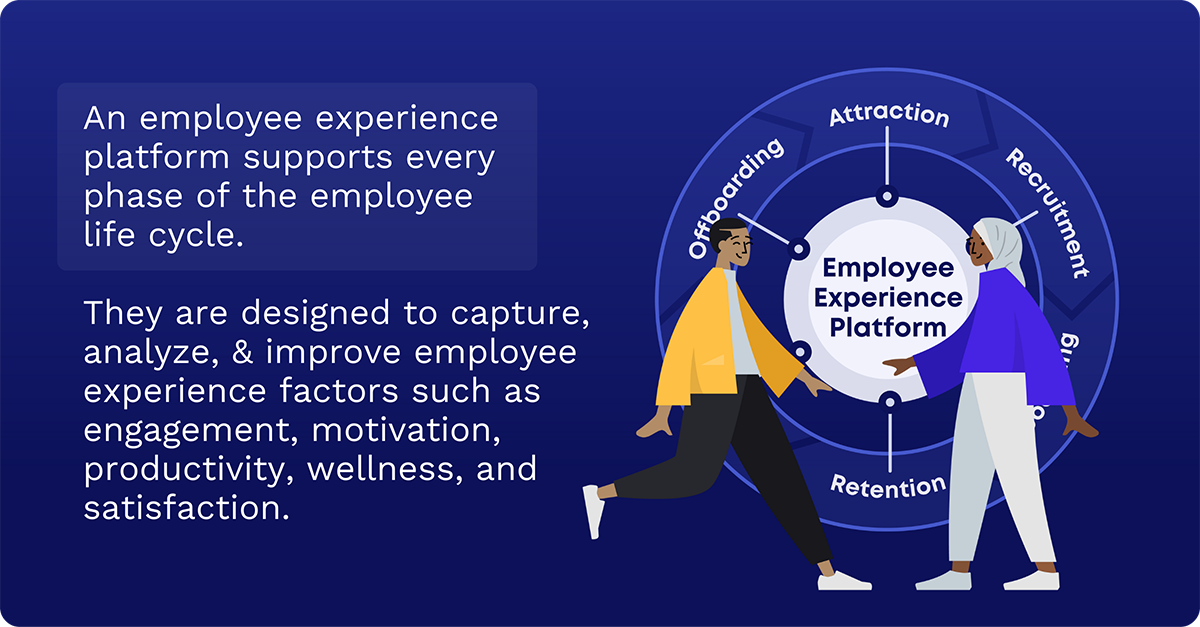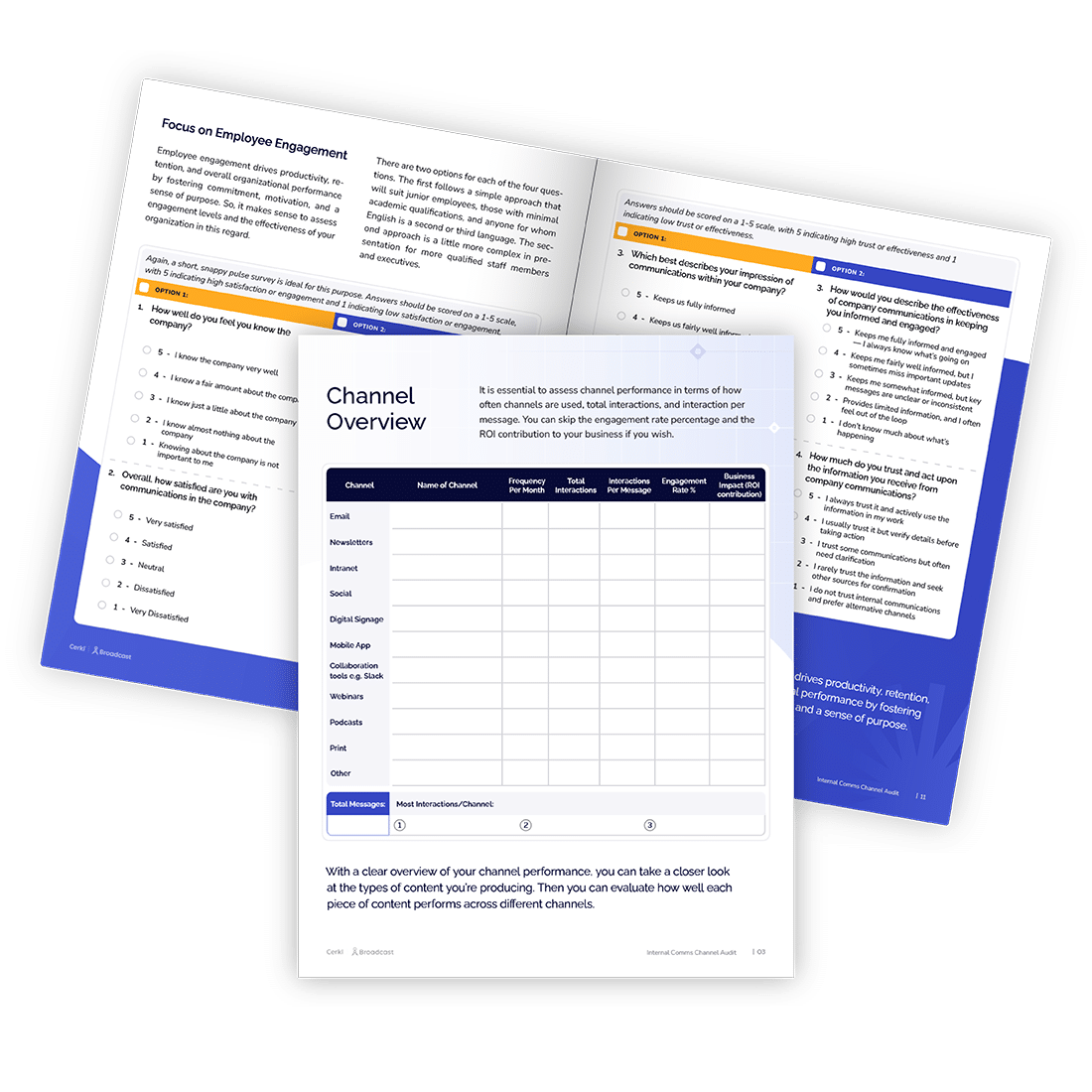Measuring employee experience is vital but can be challenging. Learn about effective, easy-to-use tools and great metrics to simplify the task.

.png)
Strategy is an important component of internal communications. Ensure you’re communicating through the right channels at the right frequency with our Internal Communications Channel Audit worksheet.
Access NowHow do you measure something as intangible as employee experience (EX)? This important aspect of the workplace plays a critical role in the satisfaction, productivity, and overall happiness of your workers. But quantifying it can be a challenge. Another issue is what to measure.
According to Gallagher’s State of the Sector 2022/23 Internal Communication and Employee Experience report, improving the way organizations measure and evaluate internal communications is one of four top priorities. But it is the larger organizations that consistently and systematically measure elements of EX, probably because they have larger teams and a greater capacity.
We’re going to start by defining employee experience. Then we’ll discuss its importance and illustrate how to measure it effectively. We will also explore different types of employee experience, both digital and physical, and recommend tools that can help you measure and gather insights for strategic planning.
The concept of employee experience is a multi-faceted one, encompassing a broad range of elements that reflect an employee's journey within an organization. From the moment an individual first comes into contact with a company, be it through a recruitment and interview process, to their day-to-day operational encounters, and their eventual departure, every interaction forms a part of the wider EX. This encompasses both their physical and digital experiences, making it a diverse area to consider when evaluating overall job satisfaction and engagement.
Despite its huge importance, in its Global Employee Experience Trends 2023 report, Kincentric states that only 51% of employees feel that their organization is delivering the experience they promised. The report points out that EX isn’t something you can work on independently of organizational culture and business goals. Rather, it needs to be put in a broader context.
“Every employee experience effort (both measurement and transformation) ultimately should start with business strategy.”
Kincentric
At the same time, Gallagher’s report states that 72% of respondents believe that employee experience is on their leadership team’s radar — an increase of 4% since their 2021/22 survey. But their respondents were from leadership, management, HR, and PR, the very people who are responsible for EX.
Another factor Gallagher highlights is that the components of EX vary. While purpose and strategy were seen by 57% of respondents to be well-defined and well-leveraged, 36% said their organization had no digital experience strategy. A further 28% said they had no structured workplace experience.

The significance of meticulously measuring employee experience reaches far beyond just HR tech or satisfying basic HR software requirements. As Kincentric points out, it plays a fundamental role in driving holistic business growth, and optimization, and ensuring business continuity.
When employees are engaged, satisfied, and feel valued, organizations are better situated to achieve their strategic objectives.
According to Zendesk’s Employee Experience Trends 2023 report, 87% of EX experts say that a great employee experience helps retain and attract talent. They identify three key growth areas:
Now, let's discuss the aspects that combine to heighten the importance of ensuring employees have a positive experience while working:
Taking these compelling benefits of prioritizing employee experience into account, organizations are increasingly investing in HR technology to gather relevant data, like the employee net promoter score, retention rates, and other EX metrics.
The process of measuring employee experience is multi-faceted as it encompasses a range of elements throughout the employee lifecycle — from the interview process to the onboarding experience, employee satisfaction, employee engagement, and eventual departure. Companies ought to differentiate between different types of employee experiences that may influence the overall perception of the workplace. Mainly, these experiences are either digital or physical.
A truly engaged employee is likely to report a positive EX across both. For example, when employee engagement is excellent, they will usually find their HR technology user-friendly and efficient while also enjoying a conducive and comfortable office environment. But, measuring employee experience is not a one-size-fits-all approach. It’s a process that acknowledges the unique dynamics of both digital and physical experiences.
An added challenge is that there is a vast discrepancy between the ways organizations of different sizes tend to measure - and what they focus on measuring. So, before we look at measuring the digital and physical experience, we’re going to look at priorities currently in practice.
Upgrade your company’s internal comms to enhance employee communication

As the Gallagher report reveals, smaller entities with fewer than 1,500 employees are more likely to focus on specifics. These include developing their people managers, enhancing leadership visibility, or building internal communications functions as they grow their businesses. Larger organizations - with up to 10,000 employees - are more concerned about improving the way they measure and evaluate the impact of internal communications. Even larger enterprise organizations, on the other hand, focus on adapting their channels to support hybrid working.
But, overall, organizations continue (as they did in the past) to measure:
Most don’t measure the business outcome or employees’ overall satisfaction with internal communication — which, of course, is the all-important employee experience.
Gallagher's survey also asked about the purposes for which organizations utilize the quantified data:
Unsurprisingly, there is a limited focus on measuring EX as such.
Digital employee experience (DEX) is increasingly becoming a crucial element of the overall employee experience, especially in today's permacrisis environment where remote and hybrid working and digital communication have become the norm. Some employees also find themselves constantly interacting with HR tech, such as HR software, which implies that ensuring a positive DEX is key to fostering overall employee satisfaction and engagement.
A good starting point for measuring DEX revolves around three important elements: accessibility, efficiency, and satisfaction. Accessibility concerns whether team members can easily access and utilize digital tools. Efficiency pertains to the digital tool's capability to assist employees in performing their tasks effectively and efficiently. Satisfaction is about how pleased team members are with the digital tool and whether it adds value to their work.
Despite the heavy emphasis on digital experiences, one simply cannot overlook the physical experiences employees have, as they contribute equally to the holistic employee journey. The physical workspace plays a significant role in shaping employee experiences, thereby affecting their engagement, productivity, and satisfaction levels. As such, key factors of a positive physical employee experience primarily include office layout, working conditions, facilities, and resources provided.
Measuring employee experience, both digital and physical, demands a structured approach that integrates employee feedback with quantifiable metrics. A comprehensive examination of these experiences will allow your HR team to derive actionable insights. It will also actively create a workplace that fuels satisfaction, engagement, and importantly, business continuity.

Employee experience metrics and key performance indicators (KPIs) are crucial for organizations to measure and improve the overall satisfaction, engagement, and productivity of their employees. Here are 10 key EX metrics and KPIs, each of which includes a definition and short description of the calculation method commonly used.
The employee net promoter score measures the likelihood of employees recommending their organization as a great place to work.
Calculation: Percentage of promoters (employees who are enthusiastic about the company) minus the percentage of detractors (employees who are dissatisfied or unhappy).
The employee engagement score measures the level of employee engagement and commitment to the organization.
Calculation: Typically based on survey responses to job satisfaction, motivation, and willingness to go the extra mile.
The retention rate is a measure of employees who stay with the organization over a specific period, indicated as a percentage.
Calculation: (Number of employees at the end of the period - Number of employees who left during the period) / Number of employees at the start of the period) * 100.
Job satisfaction is the employees' overall satisfaction with their jobs and the work environment.
Calculation: Typically gathered through surveys or feedback forms.
Performance and productivity measure individual and team performance, linking it to overall organizational goals.
Calculation: Sales targets achieved, projects completed on time, etc.
This measures employees' engagement in training and development opportunities.
Calculation: Percentage of employees participating in training programs.
To measure the all-important balance between work and personal life.
Calculation: Employee surveys may include questions about perceived work-life balance.
To measure the overall health and well-being of employees.
Calculation: This can include metrics such as absenteeism, health assessments, and healthcare costs.
A measure of the organization's commitment to diversity and inclusion.
Calculation: Percentage of diverse hires, representation in leadership positions, inclusion survey scores.
A measure of the frequency and effectiveness of feedback and recognition programs.
Calculation: Surveys or feedback mechanisms to assess how often employees receive constructive feedback and recognition.
Upgrade your company’s internal comms to enhance employee communication

Qualtrics has been tracking EX KPIs for many years and their 2024 Employee Experience Trends Report states that these are set to change in 2024. In 2023, engagement was dominated by customer-focused themes including employees feeling empowered to develop new, better ways to serve customers. In 2024, the driving forces behind engagement will be different, the report says. Specifically, meeting career goals and learning and developing are poised to rise in importance — illuminating the need for organizations to address employees’ ongoing desires for growth.
Furthermore, in 2023 the critical factors for employee well-being were the facilitation and empowerment through streamlined work processes. Qualtrics believes that this year employees will prioritize jobs that effectively leverage their skills and abilities, where they feel respected, safe, and can work with integrity.

Understanding and improving your employee experience is key to increasing engagement, satisfaction, and retention. One way to do this is by effectively measuring the factors that contribute to a positive employee experience.
‘‘Some of the most important drivers of EX for frontline workers – such as having the tools and resources to do the job and feeling psychologically safe – might seem small, but it’s oftentimes the non-obvious aspects that drive customer experience metrics.’’
Dr. Benjamin Granger, head of EX advisory services and chief workplace psychologist at Qualtrics
Finding the right tool for this crucial HR mission isn't always easy. But there are two prevalent tools that HR teams around the globe use to understand and improve employee experiences: employee surveys and employee experience platforms.
Employee surveys are one of the most feasible methods of measuring the employee experience. They provide valuable insights into employee satisfaction, engagement, and retention rates. Here are a few types of employee surveys to consider:
While these surveys can provide valuable insights, one of the potential drawbacks is response bias, as employees might feel pressured to respond positively out of fear of retribution. To overcome this, ensure that surveys are anonymous and communicate their anonymity to the employees.
Moreover, collecting data is not enough. Organizations need to act on the data they have. Deploy a scheduled follow-up plan after every survey to discuss its results and the corresponding action items with the team.
An employee experience platform is a comprehensive HR technology that integrates seamlessly with recruitment software to supports every phase of the employee life cycle, from recruitment and onboarding to development and retention — or departure.
These platforms are designed to capture, analyze, and improve various employee experience factors such as engagement, motivation, productivity, wellness, and satisfaction. They leverage a range of tools including pulse surveys, HR analytics, social recognition tools, and learning and development modules.

“Organizations must take stock of the important moments in the onboarding journey, finding ways to measure and improve them.”
Dr. Cecelia Herbert, principal catalyst at the Qualtrics XM Institute
Riverbed’s Global Digital Employee Experience (DEX) Survey 2023 advises companies to meet the “high digital expectations of younger workers.” Their research reveals that millennials and Gen Z “have the highest expectations for technology at work, with 91% of decision-makers believing they will need to provide more advanced digital experiences to meet their needs.” Ignoring this can have negative consequences.
While no tool is perfect, comprehensive platforms are now a mainstay of the HR tech industry. Like any software, though, it has specific requirements. Ensure every tool you use aligns well with your specific HR software requirements, budget, and potential integration with existing systems before opting for it.
Now equipped with rich, actionable data from your employee surveys and your experience platform, it's time to use these insights to improve your employee experience strategy.
Look for trends and patterns in the feedback you receive. Address common issues and highlight good practices. Identify the areas where improvement is needed, and then work with HR and company leaders to prioritize the changes.
With this approach, you can create an employee experience that fosters satisfied, engaged employees and ensures continuity of business functions even in the most challenging environments.
Cerkl Broadcast is an employee experience platform with everything you need from segmentation of audiences and survey strategies to feedback and invaluable analytics tools. We can help you gather insights and improve your EX strategy with ease. We can also show you how to use our employee experience equation to modernize your approach.
Discover the impact of our audience management platform, seamlessly delivering personalized emails and intranet content to captivate and enlighten your employees. Become one of the millions of satisfied professionals who depend on us to simplify their companies' communication and elevate overall employee satisfaction.
Our advice is to start with an internal communication audit that will help you improve all aspects of your internal communications.
Audit your channels to see the status and decide on what to measure.

Upgrade your company’s internal comms to enhance employee communication
How do you measure employee experience? EX can be measured through surveys, feedback mechanisms, and KPIs that gauge factors such as job satisfaction, engagement, and the overall perception of the workplace.
Why measure employee experience? Measuring EX is essential for identifying areas of improvement, enhancing organizational culture, and fostering a positive work environment. Ultimately, quantification can lead to increased productivity, employee retention, and overall employee well-being.
Which KPI is used most often to measure employee experience? Probably the most commonly used KPI used to measure EX is the employee net promoter score. It assesses the likelihood of employees recommending their workplace, in this way providing a straightforward indicator of overall satisfation and advocacy.
How to measure digital employee experience? DEX can be measured by analyzing metrics related to digital tools' usability, accessibility, and performance. Other effective measurement tools include surveys that focus specifically on digital aspects, and tracking data on the adoption of technology and proficiency of employees.

Upgrade your company’s internal comms to enhance employee communication